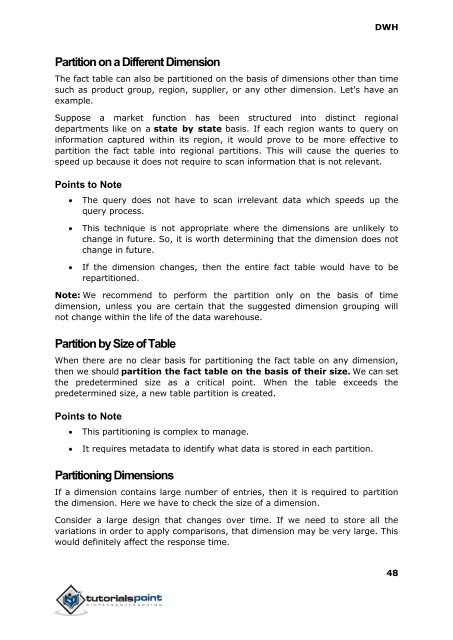dwh_tutorial
You also want an ePaper? Increase the reach of your titles
YUMPU automatically turns print PDFs into web optimized ePapers that Google loves.
DWH<br />
Partition on a Different Dimension<br />
The fact table can also be partitioned on the basis of dimensions other than time<br />
such as product group, region, supplier, or any other dimension. Let's have an<br />
example.<br />
Suppose a market function has been structured into distinct regional<br />
departments like on a state by state basis. If each region wants to query on<br />
information captured within its region, it would prove to be more effective to<br />
partition the fact table into regional partitions. This will cause the queries to<br />
speed up because it does not require to scan information that is not relevant.<br />
Points to Note<br />
<br />
The query does not have to scan irrelevant data which speeds up the<br />
query process.<br />
<br />
<br />
This technique is not appropriate where the dimensions are unlikely to<br />
change in future. So, it is worth determining that the dimension does not<br />
change in future.<br />
If the dimension changes, then the entire fact table would have to be<br />
repartitioned.<br />
Note: We recommend to perform the partition only on the basis of time<br />
dimension, unless you are certain that the suggested dimension grouping will<br />
not change within the life of the data warehouse.<br />
Partition by Size of Table<br />
When there are no clear basis for partitioning the fact table on any dimension,<br />
then we should partition the fact table on the basis of their size. We can set<br />
the predetermined size as a critical point. When the table exceeds the<br />
predetermined size, a new table partition is created.<br />
Points to Note<br />
<br />
This partitioning is complex to manage.<br />
<br />
It requires metadata to identify what data is stored in each partition.<br />
Partitioning Dimensions<br />
If a dimension contains large number of entries, then it is required to partition<br />
the dimension. Here we have to check the size of a dimension.<br />
Consider a large design that changes over time. If we need to store all the<br />
variations in order to apply comparisons, that dimension may be very large. This<br />
would definitely affect the response time.<br />
48


